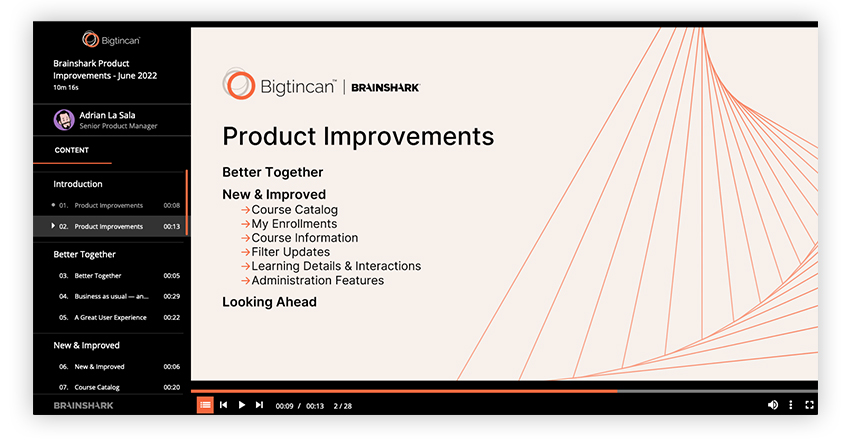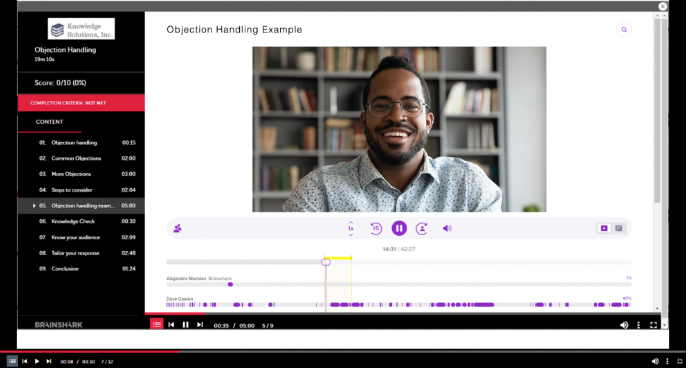Learning on the job isn’t what it used to be. Employees today face packed schedules, constant online distractions, and an endless stream of new information. Organizations that want to develop their people can’t rely on annual workshops or marathon training sessions.
Instead, the smart move is to break down complex topics into practical, focused lessons employees can review in minutes, not hours. This is the core idea behind microlearning: short, targeted bursts of education that fit into the flow of work, not the other way around.
Both companies and learners benefit — organizations can keep training relevant as things change, and employees gain flexibility and just-in-time knowledge that’s easy to revisit and apply as needed. Because it caters to busy schedules and on-demand, as needed learning, microlearning is an especially effective tool in sales training.
What are the benefits of microlearning?
Microlearning is a practical, flexible way to keep sales and other teams learning and growing. Instead of overwhelming employees with dense, all-at-once training, microlearning focuses on the essentials, delivered in a format designed for attention and retention.
Key benefits of microlearning include:
- Faster learning, lasting impact: Short, focused lessons — often under five minutes — help employees absorb and retain information more effectively.
- Better engagement: Bite-sized content reduces cognitive overload and keeps learners’ attention from drifting.
- Immediate application: Employees can quickly put new skills to use, reinforcing knowledge and making training feel relevant.
- Just-in-time support: Quick refreshers and updates are always available, so learners can revisit key concepts when they need them most.
- Flexible delivery: Microlearning works well on any device, supporting remote, hybrid, and on-the-go teams.
- Cost and time savings: Short-form modules minimize time away from daily work and lower training costs than traditional courses.
- Better customer interactions: Teams who use microlearning improve customer experience and close more deals.
When microlearning is part of a continuous learning culture, employees can build knowledge step by step, without having to hit pause on their workday.
Microlearning by the numbers
Microlearning delivers results, whether it’s part of formal training or used informally for on-demand learning. Consider these statistics:
People forget 50 percent of what they learn within the first hour of learning it.
This is explained by the Ebbinghaus Forgetting Curve, which shows how quickly our brains lose new information if it isn’t reinforced. Within just an hour, people can forget half of what they just learned — a challenge microlearning addresses by offering regular, easily digestible reviews to boost retention over time.

The half-life of information is rapidly decreasing.
The information we learn has a shelf life. Depending on the industry, facts may only be facts for a few years, months, or even days. The way information moves today is not conducive to one-time lessons; instead, people need to learn continually to keep up with the rate at which information changes.
Microlearning costs less than traditional training.
Because microlearning focuses on bite-sized training, it frees up time and budget typically spent on more traditional training processes. Microlearning is usually delivered on mobile devices and decreases the amount of time people need to spend in the classroom or formal training sessions.
In 2023, companies spent an average of $954 per learner on training, down from $1,207 per learner the previous year, reflecting a broader industry shift to more cost-effective, digital solutions like microlearning. Organizations adopting microlearning often see reduced costs not just in direct training expenses, but in time saved and decreased disruption to daily work.
Implementing microlearning
The benefits of microlearning are broad, and it is delivered best when the content is visual, served with meaningful images or videos. Content should be updated frequently to ensure learners always have the best information available.
And don’t forget about accessibility.
Remote and hybrid work push more training online. In fact, 33% of all training hours were delivered online or through computer-based technologies in 2023, and 4% via mobile devices. As remote and hybrid work continue to grow, making sure training is easy to access from anywhere (especially on computers and mobile devices) means everyone can learn when and where it works best for them.
Examples of microlearning in sales training
Onboarding new reps faster
Instead of throwing new hires into a day-long training marathon, break things up. Short videos, quick how-tos, and bite-sized lessons help new reps ramp faster without getting overwhelmed.
Reinforcing training
Don’t let training stop when the session ends. Follow up with short quizzes, flashcards, or quick scenario-based exercises to help reps actually remember what they learned—and apply it.
Rolling out product updates
Got a new feature or a pricing change? A 2-minute explainer video or a quick-hit lesson is all reps need to get up to speed — and keep the message consistent across the team.

Just-in-time learning
Reps heading into a pitch don’t need a 30-minute course — they need a quick refresher. Microlearning delivers battle cards, messaging tips, or competitive insights exactly when they need them.
Covering compliance and certifications
Mandatory training doesn't have to be painful. Break it into shorter, more manageable chunks so reps actually complete it (and retain the info). Great for regulated industries or internal certifications.
Coaching at scale
Not every rep needs the same kind of help. Microlearning makes it easy to tailor quick coaching moments based on real performance data — like giving extra objection handling practice to reps who struggle late in the deal cycle.

Sharpening soft skills
Whether it’s better storytelling, active listening, or handling tough conversations, soft skills take practice. Use short, scenario-based content to build them over time — without taking reps off the floor for hours.
Microlearning principles
Learning on the fly is more important than ever in most roles (especially sales). Even experienced employees will face new technology and processes throughout their careers. Change happens fast, and being able to adapt quickly is what sets the best teams apart.
That’s why flexibility and a willingness to keep learning are vital for anyone working today. When companies make it easy to fit training into daily routines — with quick, focused lessons — employees stay ready to take on new challenges.
But simply providing information isn’t enough. Time constraints are one of the biggest obstacles to learning and development, so the experience must be accessible and designed for success. If organizations don’t help their people to keep learning and leveling up, they risk a disengaged team, higher turnover, and losing top talent to competitors who offer more chances to grow.
Ready to make learning work for everyone — no matter where or how they work? With solutions like Bigtincan Readiness and RoleplayAI, you can deliver quick, engaging microlearning that helps your team build and practice skills, stay sharp, and keep growing every day.
